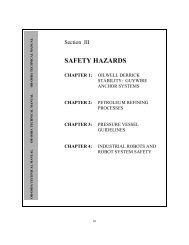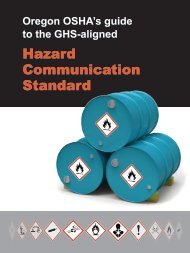Asbestos - Rules of Abatement - Oregon OSHA
Asbestos - Rules of Abatement - Oregon OSHA
Asbestos - Rules of Abatement - Oregon OSHA
Create successful ePaper yourself
Turn your PDF publications into a flip-book with our unique Google optimized e-Paper software.
• Water spray process systems may be used to remove asbestos-containing<br />
or presumed asbestos-containing materials from cold-line piping if<br />
employees carrying out the process have completed a 40-hour training<br />
course on its use in addition to training required for all employees<br />
performing Class I work.<br />
• A walk-in enclosure that accommodates no more than two people (minienclosure)<br />
may be used if the disturbance or removal can be completely<br />
contained by the enclosure.<br />
Employers may use different or modified engineering and work-practice<br />
controls if the following provisions are met (DEQ/LRAPA must approve all<br />
alternatives in writing):<br />
• The control method encloses, contains, or isolates the process or source<br />
<strong>of</strong> airborne asbestos dust or captures and redirects the dust before it<br />
enters into the employees’ breathing zone.<br />
• A certified industrial hygienist or licensed pr<strong>of</strong>essional engineer qualified<br />
as a project designer evaluates work area, work practices, and engineering<br />
controls. That person must certify, in writing, that the planned control<br />
method adequately reduces direct and indirect employee exposure to or<br />
below PEL under worst-case conditions. The planned control method<br />
must also prevent asbestos contamination outside the regulated area. This<br />
must be determined by samplings meeting the requirements <strong>of</strong> the “EPA<br />
<strong>Asbestos</strong> in Schools” rule or perimeter monitoring.<br />
Class II work<br />
The competent person must supervise all Class II work. The DEQ-licensed<br />
supervisor must be on site if more than three linear feet <strong>of</strong> material is removed.<br />
Employers must use critical barriers over all openings to the regulated area or<br />
another barrier or isolation method to prevent airborne asbestos from migrating<br />
for the following:<br />
• All indoor Class II jobs without a negative exposure assessment<br />
• Situations where changing conditions indicate exposure above the PEL<br />
• Situations where asbestos-containing materials are not removed<br />
substantially intact<br />
Otherwise, employers must perform perimeter-area monitoring to verify that<br />
the barrier works properly. Impermeable drop cloths must be placed on all<br />
surfaces beneath removal activities.<br />
All Class II asbestos work can use the same work practices and requirements<br />
as Class I asbestos jobs. Alternatively, Class II work can be performed more<br />
easily using simple work practices set out in the standard for specific jobs.<br />
DEQ/LRAPA requires approval in writing for any alternative that involves<br />
removal <strong>of</strong> friable asbestos material or any material that may become friable<br />
when physically altered during the removal process.<br />
23
















